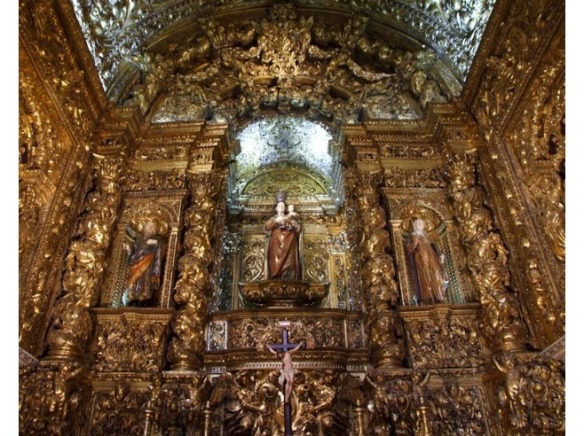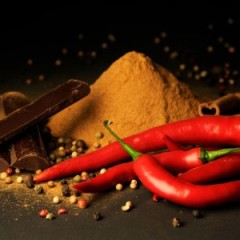Black Phantom (“Memento Mori”), the latest fragrance from By Kilian, is a fragrance that is a far cry from the terms and imagery surrounding it. The phrase “Memento Mori” means “remember you must die” in Latin, and was given to objects which were meant to make you ponder or remember your mortality, like skulls. And, indeed, a glittering black skull is placed right on top of Black Phantom’s perfume box.
Tag Archives: Gourmand fragrances
Serge Lutens Arabie: Souks, Spices & Sweets

Photo: Nahid Sultana Tithi via his site, Journey Around The Globe. (Direct website link embedded within.)
Close your eyes and imagine yourself spending a day in an old souk, perhaps in Marrakesh or Tripoli. The air is thick with heat, so you buy a refreshing drink of blood oranges infused with Angostura aromatic bitters, decorated with candied orange peels and sprigs of fresh herbs. One vendor catches your eye, his tables piled high with leathery black figs, the fattest, stickiest Medjool dates, syrup-laden Middle Eastern sweets, and honeyed desserts. Large sacks of colourful spices lie on the ground, next to ones filled with bitter Bay Leaf, oregano, and other green herbs. Nearby, bottles of rich labdanum amber and leathery Tolu balsam resins surround gleaming silver trays filled with cinnamon-scented, hard, dark benzoin resinoids.
An enterprising chap, the seller even offers you cooked food in case you missed your lunch, large bowls filled with curries or banana-leaf savory dishes straight from his Indian wife’s kitchen. You stand before his wares, sipping your drink of herbal Angostura bitters and orange, nibbling on a dried date as you contemplate ordering either a main meal or dessert. Suddenly, a vendor on a bike comes out of nowhere and crashes into you. The barrel of immortelle in the back goes flying into the air, crashing into the tables, throwing everything to the ground, and releasing a flood of sticky syrup over them all. Apologizing profusely, the vendor offers to cook you dinner in his kitchen. Hours later, he replaces your ruined clothing with an outfit made of soft Tuareg leather, but the resins from the accident still coat your skin, encasing you in a cloud of amber infused with spices, sweet myrrh, and sweetness.
Perfume Review – Arquiste Anima Dulcis: Conquistadors, Convents & Chocolate
It was a chilly day in Mexico City that November, long ago in 1695, and the kitchens of the Royal Convent of Jesus Maria were a beehive of activity. The haughty Mother Superior took the heavy key from the chain around her neck and unlocked the vault with the sisters’ most precious ingredients: bitter, dark chocolate, rich chilies, earthy spices, incense used in their religious ceremonies, and the heaviest of vanillas. The recipe for their famed “Anima Dulcis” was a secret one — even some of the nuns weren’t privy to its true magic. Were there flowers hidden under its dark depths? Was ancient incense responsible for its smoke, or was it darkened patchouli? The Mother Superior smiled to herself as she passed through the convent’s stone passageways and heard the younger sisters’ whispered questions. She, and she alone, would add the finishing touches.

The chapel of Sao Roque Church, Lisbon, which is a little how I imagine the wealthy Royal Convent in my mind. Photo: “ToonSarah” on VirtualTourist.com
The Royal Convent of Jesus Maria in Mexico City on a day in November 1695, is the explicit reference point for the “baroque gourmand” fragrance that is Anima Dulcis (loosely translated as “soul of sweetness”). It comes from the perfume house of Arquiste, founded by the Mexican architect and designer, Carlos Huber. Mr. Huber — who just won the Fashion Group International’s Rising Star award a few weeks ago — was inspired by the convent’s history and practices after he worked on renovating and converting the building in Mexico City.
As Mr. Huber explains on the Arquiste website, the Royal Convent of Jesus Maria had been founded in 1578 for the female descendants of the Spanish Conquistadors. (Or, at least, the very wealthiest and most aristocratic among them!) It was known for the nuns’ recipes which combined European and Asian ingredients with those particular to Mexico’s ancient history. Octavian, the highly respected perfume blogger of 1000 Fragrances, elaborates further in his beautiful review of the perfume:
The most carnal elements of the baroque cuisine were mixed in unexpected combinations, forgotten by the modern nose. Animalic jasmine, tuberose, petals of white flowers and all the temptations of the flesh were mixed with cocoa and hot spices to produce liqueurs and sweets. The nuns were discovering the fabulous scents of the new world, earlier than Europe. Vanilla, cocoa and tuberose, brought to Versailles, but still a great luxury before their massive use in the next century, made their debut in a Convent where the ancient Maya and Aztec flavors were tested and studied by Europeans. Anima dulcis, a modern interpretation of this magic encounter, tells the story of when the european sensibility started to use the “dark” ingredients of the New World – the discovery of cocoa, vanilla and chili pepper, reported by Cortez 150 years earlier. [Emphasis in the original.]
Using his research (and, I believe, the sisters’ actual recipes), Carlos Huber worked with two perfumers, Yann Vasnier and Rodrigo Flores-Roux, to encapsulate the Convent’s creations. The result was Anima Dulcis which was released in 2011. It is classified on Fragrantica as an “oriental vanilla,” though I think “oriental chocolate” might be a more accurate summation. On its website, Arquiste says the notes include:
perfumers, Yann Vasnier and Rodrigo Flores-Roux, to encapsulate the Convent’s creations. The result was Anima Dulcis which was released in 2011. It is classified on Fragrantica as an “oriental vanilla,” though I think “oriental chocolate” might be a more accurate summation. On its website, Arquiste says the notes include:
Cocoa Absolute, Mexican Vanilla, Cinnamon, Chili infusion.
Those official notes are just the tip of the iceberg. There is no way that the list is complete. I would venture a guess that the complete list might possibly look a little bit like this:
Cocoa Absolute, Mexican Vanilla, Cinnamon, Red Chili infusion, Jasmine Sambac (or some sort of florals), Seville Oranges, Cumin, Cardamom, Patchouli, Incense and, possibly, some sort of ambery resin.
Anima Dulcis opens on my skin with cinnamon-infused dark chocolate. It’s chewy, dusky, and spiced, but also, simultaneously, honeyed. Fiery red chilies counter the sweetness of the vanilla that just barely seems to breathe in the background. So does the earthiness of a dark patchouli — dirty and slightly smoky in the best way possible. The smoky notes seem to be further accentuated by some hint of light incense. It’s a lovely take on vanilla and chocolate, especially with the piquancy from the red chili pepper.

Mexican Hot Chocolate. Source: Zested.com. (Click on the photo to go to the website where you can find a tasty recipe.)
The chocolate note, however, is the real star. It’s unusual and nothing like the typical sort of chocolate notes which, to me, often feel more like powdery cocoa. At the same time, it’s also not like purely dark chocolate. Here, it’s more like the richest chocolate flourless cake covered with ganache made from bitter chocolate, covered by a dusting of smoky powder, cinnamon, cumin, cardamom, decorated with faint slivers of Madagascar vanilla pods, and then set on a plate of spicy, cinnamon red-hot candies. The richness almost has the feel of a British Christmas plum pudding, only tinged with incense.
It’s an incredibly cozy scent that is, at the same time, very sexy. There is a rich, meaty, chewy, dark aspect to it that can certainly be called “baroque” but, to be honest, aristocratic Mexican nuns descended from the Conquistadors are not really what comes to mind when I smell it.
Instead, I feel transported to a secluded wood cabin in Vermont on a very snowy, wintery night; there, by the light of a roaring fire which casts flickering shadows on the wall, a seduction scene full of deep long kisses and teasing nuzzles unfolds. Cups of spiced hot chocolate filled with dark liqueurs lie empty; the fire releases an occasional tendril of smoke; the light is glowing amber and red; and sensuality underlies the cozy warmth of the scene.
As time progresses, the baroque chocolate notes are joined by something that is definitely floral in nature. It’s lovely, adding a lightness and sweetness to the dry spices, but I can’t pinpoint the exact flower. Perhaps Jasmine sambac, with its earthier, muskier nature than regular jasmine? Octavian on 1000 Fragrances thinks it’s a green lily note and, while I can see some light greenness, I don’t think it’s the delicate lily flower. Either way, the perfume definitely has some sort of floral component. Carlos Huber may consider Anima Dulcis as a “baroque gourmand,” but, to my mind, it is much more of a spicy oriental perfume which just happens to have some gourmand elements. It’s also a very ambery perfume for something that is meant to smell like Mexican hot chocolate, and I wonder if there is some sort of resin in Anima Dulcis’ foundation. Whatever the specific notes, it’s a fascinating and addictive scent. I can’t stop sniffing my arm, and I just barely stifle the urge to put on more.
Two hours in, the perfume shifts and changes a little. It is now predominantly cinnamon orange with red chili peppers. There is a feeling of caramelized cooked fruit, where the caramel has burnt just a little. Or, maybe, it’s more like a sticky, toffee’d orange, salted and sweet, mixed with dark raisins stewed in rum and dark chocolate. It’s really hard to pinpoint; the perfume is superbly blended, leading all the notes to melt together in a decadently luscious, rich whole. The burnt note, unfortunately, lasts a wee bit too long for my liking, and seems to become just a tad bit more bitter and burnt with time. It’s not strong and over-powering — it’s not even the predominant note — but I think I would have liked just a little less of it or, perhaps, a little more sweetness to counter it.
After another hour, it fades, leaving Anima Dulcis as a lovely combination of bitter Seville oranges, dark patchouli, cinnamon, chili pepper and a soft dusting of sweet vanilla. Eventually, at the end of the fourth hour, the perfume turns into a soft amber with spices and just a flicker of orange, before finally ending up in its final stage as sweet vanilla and light white cocoa powder, with just a smidgen of dusty spice.
For all that these notes seem dark and heavy, the perfume itself actually is not. It’s neither narcotically heady nor cloyingly sweet. It’s not a light, clean, airy scent by any means — no laundry detergent freshness here — but it’s surprisingly not heavy or opaque either. Octavian describes it as “light, woody, airy” and “delicate.” I think it’s a bit heavier than that; I wouldn’t want anyone to think this is a sheer, translucent scent or something like the minimalistic creations made by Jean-Claude Ellena. But, given the richness of some of its components, it is far from thick and never overbearing.
In fact, even the sillage is moderate. In the beginning, you can smell it on yourself but it’s far from overpowering. Someone across the room definitely won’t be gassed by it. After the first hour, the perfume becomes softer and, by the third hour, it was quite close to my skin. By the fourth hour, it took some determined sniffs, putting my nose right on the skin, to detect some of the nuances in the notes. As for longevity, it was moderate on my perfume-consuming skin. It faded away shortly before the sixth hour. On others, I’ve read lengths of time around varying between six and eight hours.
All in all, I really liked Anima Dulcis. A lot. The only thing stopping me from wanting a full bottle is the fact that, for my personal tastes, I would have preferred it if the scent were heavier, headier, and just a slightly bit sweeter. (Just a smidgeon!). I realise, however, that most people don’t share my preference for narcotically heady scents, so I think Anima Dulcis would be a real crowd-pleaser for many. It taps into the current trend for gourmand scents but, in my opinion, it really isn’t one. Those who are expecting a true dessert fragrance will be disappointed. This is not half as sweet as some of the niche Guerlains that are out there. Those, however, who share my feeling that a few of those Guerlains are a bit too gourmand should really look into Anima Dulcis. The same applies to anyone looking for a very high-quality, luxurious take on spicy Orientals without the heavy, boozy or opaque aspects that can sometimes accompany them. I should add that it is most definitely unisex!
Try Anima Dulcis, and see if a perfume twist on a recipe from the aristocratic descendants of the Conquistadors over three hundred years ago touches your sweet soul.








